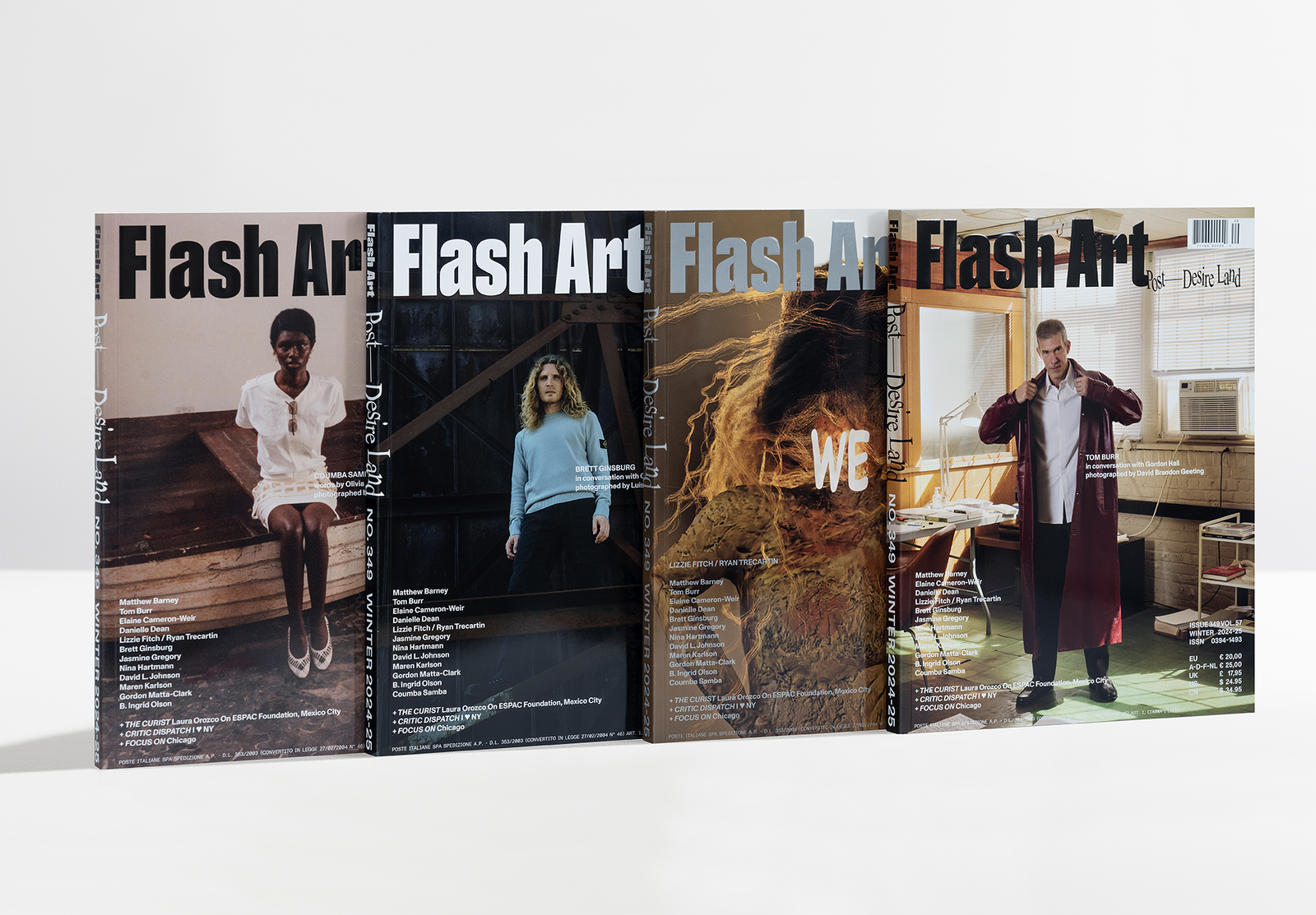Winter 2024–25
December 4, 2024
We find ourselves in a prolonged period of disillusionment with America, in which the world seems to draw energy from the country, yet some aspects feel impossibly distant. It is as though every part of us has been depleted, and now it’s time to seek some form of reckoning. This encompasses social, cultural, and economic dimensions—an uneasy enrichment that has led to a complex love-hate relationship with a nation that has invested in its people, only to substitute that investment with technology and artificial intelligence.
This winter issue of Flash Art delves into the essence of desire in today’s context, and explores what it means to be an artist in the United States at this moment. With terms like “brat” and “demure” being used to describe various lifestyles, we are prompted to consider what a new understanding of desire might look like. Following Shumon Basar’s concept of “endcore,” which captures the anxiety that social media, alarming news, and tumultuous historical moments have instilled in our society, we ask ourselves: Is desire still something we yearn for?
For this issue, we invited artists working in different media to aphorize the idea of desire or anti-desire.
Tom Burr, in conversation with Gordon Hall, discusses the origins of his Torrington Project, an endeavor stemming from Burr’s desire to allow works created over the years to share the same space and engage in dialogue with one other, as well as his dissatisfaction with the constraints of the current art system. The project represent a space for rethinking artistic practice. Burr appears on the cover of the winter issue, photographed by David Brandon Geeting in his studio in Torrington, wearing Gucci.
On the occasion of their show “It Waives Back” at Fondazione Prada in Tokyo, Lizzie Fitch and Ryan Trecartin contributed to this issue with a striking visual essay featuring stills from their latest film, TITLE WAIVE (2019–24) — a dynamic collage of moments, recorded over seven years on Fitch and Trecartin’s property in Ohio — along with archival images. Fitch and Trecartin have created a special visual piece for the cover.
Brett Ginsburg talks to Cusson Cheng about the nuances of his spatial choreographies. Together, they examine the ebb and flow of meaning in contemporary art, and the art of manipulating the viewer’s perspective through a transformative experience that resonates beyond the typical white cube space. For his cover story, Ginsburg was photographed by Luis Corzo in his studio in New York, wearing Stone Island.
Coumba Samba is profiled by Olivia Kan-Sperling for this issue, in an exploration of Samba’s multifaceted practice, which includes paintings, performance, and also music, to communicate raw emotion, many references, and life being compressed into something deceptively easy to consume. Samba appears on the cover photographed by Lengua in London, wearing Stefan Cooke and Kuboraum.
Also in this issue: Travis Diehl examines Matthew Barney’s latest film, Secondary (2023), in which football serves as pantomime for war, complete with generals, strategies, politics, tactics, and drills; Margaret Kross offers a reading of Jasmine Gregory’s art and her post-American vision of chaos, distress, and a profound amount of contemporary beauty; Marie Catalano writes about the technology of Maren Karlson’s paintings, with their distinctive visual language that echoes both the fantasies and anxieties of a particularly spectral brand of frictionless American capitalist production on offer in Los Angeles; starting from her most recent show, “A WAY OF LIFE” at Lisson in New York, Caroline Elbaor delves into Elaine Cameron-Weir’s practice, which can be read as an indictment of how willingly we consume arbitrary dictums in order to provide our lives with definition and meaning; and Gea Politi explores Nina Hartmann’s post-meme and post-game-book practice, which prioritizes subjectivity over traditional concepts of “truth” and “accuracy.”
This issue’s installment of Archive honors the practice of Gordon Matta-Clark with a text by Ted Castle from 1979 and two short pieces by the artist himself, written in 1976; Critic Dispatch by Daniel Merritt is a melancholic hymn to New York City, starting from Anna Rubin’s latest video, The Gram (2024); for The Curist, a column focusing on experimental curatorial and editorial approaches to gallery culture, Leslie Moody Castro speaks to Laura Orozco, founder and director of ESPAC Foundation in Mexico City; this issue’s Focus On city is Chicago, as Mark Acciari looks at the enduring legacy of Stanley Tigerman; Alex Bennett’s final installment of Unpack / Reveal / Unleash is dedicated to B. Ingrid Olson and her work that gives “proximity to suddenness”; Studio Scene, a new column inaugurated by David L. Johnson, includes Jessica Kwok’s insight into Johnson’s practice and the importance of absence in it; Letter from the City, penned by Danielle Dean from Los Angeles, reflects on the interplay between reality and fiction.
Reviews
Energies Swiss Institute, New York, by Hindley Wang / Scientia Sexualis ICA, Los Angeles, by Meka Boyle / Mike Kelley Ghost and Spirit Tate Modern, London, by Isabelle Buckle / Martine Syms Total Lafayette Anticipations, Paris, by Hugo Bausch Belbachir / Chiffon Thomas Perrotin, Paris, by Qingyuan Deng / After Images Julia Stoschek Foundation, Berlin, by Philipp Hindahl / Cosima von Bonin “Songs for Gay Dogs” Mudam, Luxembourg, by Ben Broome.
The issue will be available for preview at Art Basel Miami Beach from December 4 to 8, 2024.

